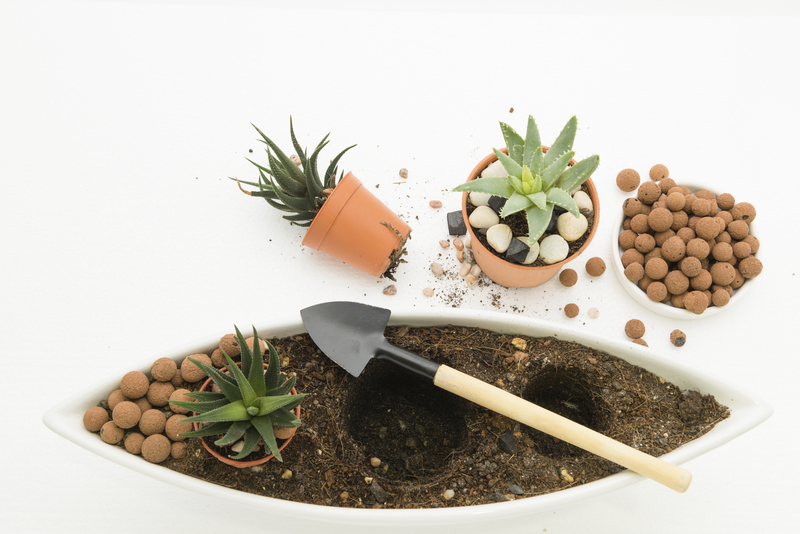Guide to growing fresh herbs: for culinary use and beyond
Posted on 16/09/2025
Guide to Growing Fresh Herbs: For Culinary Use and Beyond
Ever wonder how your favorite chefs garnish soups with vibrant basil or transform simple dishes with the magic of fresh thyme? Growing your own fresh herbs at home isn't just for seasoned gardeners or culinary experts--it's an accessible, rewarding hobby that brings flavor, health, and beauty into everyday life. Whether you live in a city apartment or a country homestead, this comprehensive guide covers everything you need to know about growing herbs for cooking and other creative uses.
Why Grow Fresh Herbs?
There are countless reasons to start cultivating fresh herb plants:
- Enhanced Flavor: Freshly picked herbs elevate dishes with unparalleled aroma and taste.
- Cost-Effective: Growers save money over buying small plastic-wrapped bunches.
- Self-Sufficiency: Home-grown herbs mean fewer trips to the store.
- Healthier Lifestyle: Enjoy nutrient-rich, pesticide-free produce.
- Versatility: Herbs offer uses beyond the kitchen--from natural remedies to fragrant home decor.

Getting Started: Choosing the Right Herbs to Grow
For herb gardening beginners and experts alike, it's helpful to select varieties suited to your climate, culinary preferences, and available space.
Top Culinary Herbs for Home Gardens
- Basil - Essential for pesto and Italian cuisine.
- Parsley - Universal garnish with a mild, fresh flavor.
- Thyme - Earthy and versatile for meats and vegetables.
- Rosemary - Woody, aromatic, and perfect for roasts.
- Mint - For teas, desserts, and refreshing drinks.
- Cilantro - A staple in Mexican and Asian dishes.
- Chives - Mild and oniony, great for salads and soups.
- Dill - Adds flavor to fish, pickles, and sauces.
*Tip: If you're short on space, select compact or container-friendly herbs such as basil, chives, and mint.*
Herb Garden Basics: Indoors or Outdoors?
One of the joys of growing fresh herbs is their adaptability. You don't need a sprawling backyard--windowsills, balconies, and patios offer suitable environments, too.
Benefits of Indoor Herb Gardening
- Year-round access to fresh flavors
- Convenience for frequent cooking
- Less exposure to pests and harsh weather
Best Herbs to Grow Indoors
- Basil
- Chives
- Mint (in containers to control spread)
- Parsley
- Cilantro
Outdoor Herb Gardening Advantages
- Sunlight abundance (6-8 hours daily for most herbs)
- Larger harvests and bigger plants
- Greater variety possibilities
Planning Your Herb Garden: Location, Containers, and Soil
Selecting the Right Location
Sunlight is vital! Most culinary herbs require at least 6 hours of direct sunlight every day. South or west-facing windowsills or a balcony with plenty of light work well for indoor gardens. If outdoor, select a well-drained bed or raised planter box.
Choosing Containers
If you're restricted in space or prefer flexibility, container gardening is an excellent strategy. Herbs thrive in pots, window boxes, or hanging planters. Ensure:
- Pots have drainage holes
- Containers are at least 6-12 inches wide and deep, depending on the herb
Optimal Soil for Growing Herbs
A well-draining, nutrient-rich soil mix supports robust herb growth. Use a quality potting mix fortified with compost for nutrients. Avoid heavy garden soil, which can compact and suffocate roots.
Pro Tip: For Mediterranean herbs like thyme, rosemary, and oregano, include a bit of sand or perlite for extra drainage.
How to Grow Herbs from Seeds or Seedlings
Growing herbs from seed is rewarding and economical, though seedlings offer a head start. Here are steps for both approaches:
Starting from Seeds
- Read the Seed Packet: Check for depth, spacing, and any special sowing instructions.
- Use Seed Trays or Small Pots: Fill with damp, high-quality potting mix.
- Sow Seeds Lightly: Cover with a thin layer of soil; mist gently.
- Provide Warmth: Place trays near warmth (70?F/21?C is ideal for most herbs.)
- Maintain Moisture: Keep soil moist but not soggy. Covering trays with plastic can help retain humidity until germination.
- Hardening Off: Gradually adjust seedlings to indoor or outdoor conditions before transplanting.
Using Seedlings or Starter Plants
- Buy healthy, disease-free seedlings from a nursery or garden center.
- Transplant gently into containers or prepared beds, keeping roots intact.
- Water thoroughly after planting.
Ongoing Herb Care: Watering, Feeding, and Pruning
Watering Tips for Healthy Herbs
- Herbs generally prefer slightly moist soil--never waterlogged or bone dry.
- Basil and parsley like more regular water, while rosemary and thyme prefer soil to dry out slightly between waterings.
- Always water at the base to avoid wetting foliage, which can lead to fungal issues.
Feeding and Fertilization
Herbs are light feeders. Use a diluted balanced fertilizer (almost half the recommended strength) once a month during the growing season. Over-fertilizing can reduce aroma and flavor.
How to Prune and Harvest for Thriving Plants
- Pinch or cut stems above a leaf set to encourage bushier, denser growth.
- Never harvest more than one-third of the plant at a time.
- Regular pruning keeps herbs productive and delays flowering, which can alter flavor.
Dealing with Common Herb Gardening Challenges
Pests and Diseases
- Aphids, whiteflies, and spider mites: Remove with a strong jet of water or use insecticidal soap.
- Fungal issues: Improve air circulation, avoid overwatering, and water only at the base.
- Slugs and snails: Use organic deterrents like copper tape or hand pick.
Environmental Stresses
- Wilting or yellow leaves may indicate over or under-watering. Check soil moisture regularly.
- Leggy growth usually means not enough sunlight; move your herbs to a brighter spot.
Creative Uses for Fresh Herbs: Beyond Cooking
Fresh Herbs in the Kitchen
- Garnishes: Sprinkle chopped parsley, chives, or basil over finished dishes for color and taste.
- Infused Oils & Vinegars: Steep sprigs of rosemary, thyme, or tarragon in olive oil or vinegar for an aromatic condiment.
- Herb Butters: Blend soft butter with finely chopped herbs for spreading on bread, grilling, or finishing vegetables.
- Flavorful Teas: Steep mint, lemon balm, or basil in hot water for soothing, caffeine-free beverages.
Herbs for Wellness and Natural Remedies
- Herbal teas for calm and digestion (e.g., chamomile, peppermint, lemon balm).
- Bath soaks using lavender, rosemary, or mint for relaxation and skin benefits.
- Salves and balms infused from calendula or comfrey for minor cuts and skin irritations.
Herbs in the Home and Garden
- Natural air fresheners: Hang bunches of aromatic herbs like sage or rosemary to scent your kitchen or entryway.
- Pest repellents: Place pots of mint or basil around patios to deter mosquitoes.
- Bouquets and decor: Create herbal wreaths or table arrangements for rustic, fragrant beauty.
Storing and Preserving Fresh Herbs
Even the most abundant harvests won't last forever, but there are several ways to preserve the flavors of your home-grown herbs:
Drying
- Hang small bunches upside down in a cool, dry place.
- Strip dried leaves and store in airtight containers away from direct sunlight.
Freezing
- Chop and fill ice cube trays with herbs, top with water or oil, and freeze for soup-ready portions.
- Whole sprigs or leaves can be frozen in zip-lock bags--best for hardy herbs like rosemary or thyme.
Herb Vinegars, Oils, and Butters
- Preserve the essence of basil, tarragon, or rosemary in homemade infused oils or vinegars.
- Herb butters freeze beautifully and can be sliced as needed.

Conclusion: Enjoying Home-Grown Herbs for Life
Whether you're growing herbs for cooking, for health, or to beautify your surroundings, the rewards are plentiful. With a pinch of planning and care, anyone can bask in the aroma of fresh basil or snip chives for a finishing touch. Plus, the process--seed to harvest--is a therapeutic journey that brings you closer to your food and nature.
Start your herb gardening adventure today: your garden, your windowsill, or even your kitchen counter can become a source of inspiration, nourishment, and delight for all seasons.
Frequently Asked Questions about Growing Fresh Herbs
- Can I grow herbs year-round indoors?
Yes! With adequate sunlight, most herbs thrive on a sunny windowsill all winter. Supplemental grow lights also work wonders. - How do I prevent indoor herbs from getting leggy?
Ensure they get at least 6-8 hours of direct light and prune regularly for bushier growth. - What herbs are easiest for beginners?
Basil, chives, parsley, and mint are forgiving and quick to grow. - Can I mix different herbs in the same container?
Yes, but select herbs with similar water and light needs. For example, rosemary and thyme pair well, but don't mix mint (which is invasive) with other herbs.
Ready to begin your journey? Explore the world of herb gardening and discover flavors, aromas, and uses that transform your kitchen and your life!

